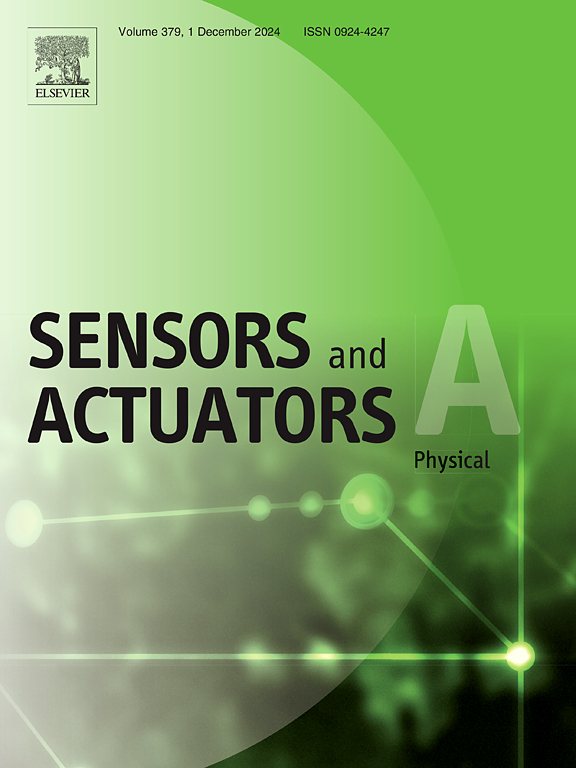基于田口方法的触觉应用电渗透泵的设计优化和性能增强
IF 4.1
3区 工程技术
Q2 ENGINEERING, ELECTRICAL & ELECTRONIC
引用次数: 0
摘要
随着扩展现实(XR)技术的迅速发展,触觉反馈系统在人机界面中发挥着至关重要的作用。然而,传统的触觉反馈装置由于受致动器尺寸的限制,面临着重量过大、能耗高的挑战。本研究采用田口方法优化电极嵌入式电渗透泵(EEOPs)的电极几何结构,以提高其触觉反馈性能。通过对导体圆直径、孔直径、孔间距、栅格线间距等关键几何参数的系统研究,建立了eeop优化设计准则。实验结果表明,优化设计的流速为96.67 μL/5 s。时间分析显示两个不同的运行阶段:流速为0.25 μL/ms的初始阶段(0-800ms)和流速为0.14 μL/ms的稳定阶段(800-2000ms)。与之前的设计相比,优化后的EEOPs在初始阶段的流量提高了188 %,在稳定阶段的流量提高了73-79 %。优选的孔导面积比范围为19.35 ~ 32.857 %。此外,标准化的制造过程和模块化控制系统的开发,以确保实验的可重复性和系统的稳定性。研究结果为触觉反馈应用中的高性能eeop提供了全面的设计指南,并为未来多通道触觉反馈系统的开发奠定了基础。本文章由计算机程序翻译,如有差异,请以英文原文为准。
Design optimization and performance enhancement of electroosmotic pumps for tactile applications using Taguchi-based methodology
With the rapid development of Extended Reality (XR) technology, haptic feedback systems play a crucial role in human-machine interfaces. However, traditional haptic feedback devices face challenges of excessive weight and high energy consumption due to actuator size limitations. This research applies the Taguchi method to optimize the electrode geometric structure of Electrode-embedded Electroosmotic Pumps (EEOPs) to enhance haptic feedback performance. Through systematic investigation of key geometric parameters including conductor circle diameter, hole diameter, hole pitch, and grid line spacing, optimal design criteria for EEOPs were established. Experimental results demonstrated that the optimized design achieved a flow rate of 96.67 μL/5 s. Temporal analysis revealed two distinct operational phases: an initial phase (0–800ms) with flow velocity reaching 0.25 μL/ms, and a stable phase (800–2000ms) maintaining 0.14 μL/ms. Compared to previous designs, the optimized EEOPs showed 188 % flow rate improvement in the initial phase and 73–79 % enhancement in the stable phase. The study established an optimal hole-to-conductive area ratio range of 19.35–32.857 %. Additionally, standardized manufacturing processes and modular control systems were developed to ensure experimental repeatability and system stability. The research findings provide comprehensive design guidelines for high-performance EEOPs in haptic feedback applications and establish foundations for future multi-channel haptic feedback system development.
求助全文
通过发布文献求助,成功后即可免费获取论文全文。
去求助
来源期刊

Sensors and Actuators A-physical
工程技术-工程:电子与电气
CiteScore
8.10
自引率
6.50%
发文量
630
审稿时长
49 days
期刊介绍:
Sensors and Actuators A: Physical brings together multidisciplinary interests in one journal entirely devoted to disseminating information on all aspects of research and development of solid-state devices for transducing physical signals. Sensors and Actuators A: Physical regularly publishes original papers, letters to the Editors and from time to time invited review articles within the following device areas:
• Fundamentals and Physics, such as: classification of effects, physical effects, measurement theory, modelling of sensors, measurement standards, measurement errors, units and constants, time and frequency measurement. Modeling papers should bring new modeling techniques to the field and be supported by experimental results.
• Materials and their Processing, such as: piezoelectric materials, polymers, metal oxides, III-V and II-VI semiconductors, thick and thin films, optical glass fibres, amorphous, polycrystalline and monocrystalline silicon.
• Optoelectronic sensors, such as: photovoltaic diodes, photoconductors, photodiodes, phototransistors, positron-sensitive photodetectors, optoisolators, photodiode arrays, charge-coupled devices, light-emitting diodes, injection lasers and liquid-crystal displays.
• Mechanical sensors, such as: metallic, thin-film and semiconductor strain gauges, diffused silicon pressure sensors, silicon accelerometers, solid-state displacement transducers, piezo junction devices, piezoelectric field-effect transducers (PiFETs), tunnel-diode strain sensors, surface acoustic wave devices, silicon micromechanical switches, solid-state flow meters and electronic flow controllers.
Etc...
 求助内容:
求助内容: 应助结果提醒方式:
应助结果提醒方式:


